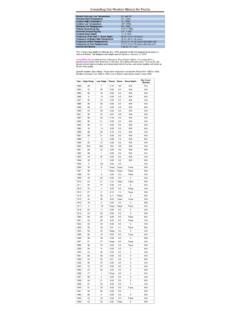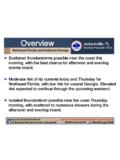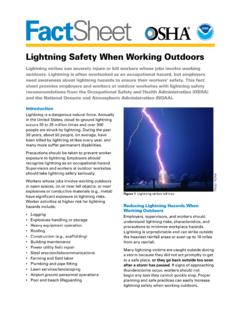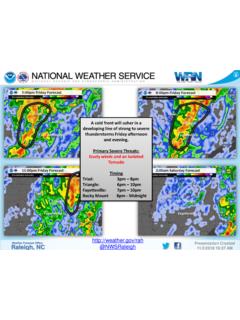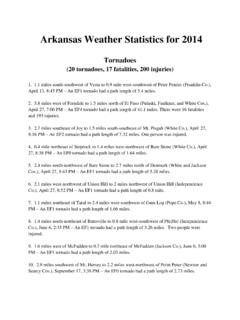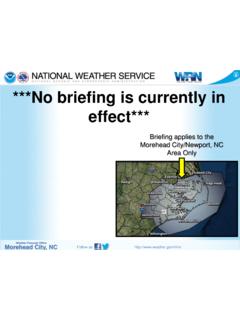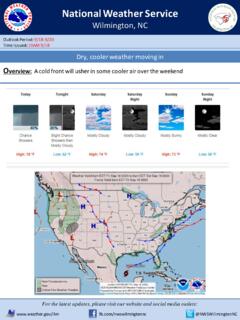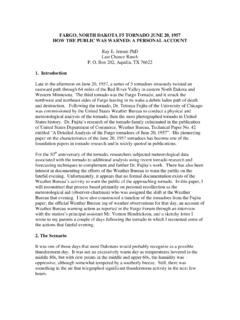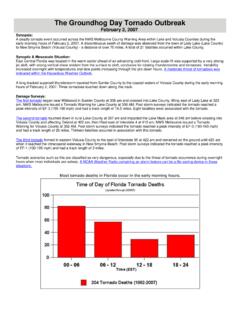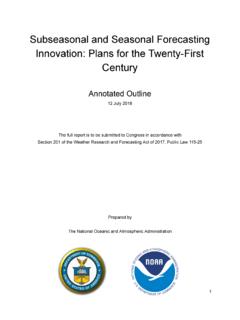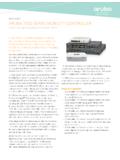Transcription of Cloud Classifications and Characteristics
1 By Ted Funk Science and Operations Officer Cloud Classifications and Characteristics Clouds are classified according to their height above and appearance (texture) from the ground. The following Cloud roots and translations summarize the components of this classification system: 1) Cirro-: curl of hair, high; 2) Alto-: mid; 3) Strato-: layer;. 4) Nimbo-: rain, precipitation; and 5) Cumulo-: heap. Cirrus clouds (above). High-level clouds: High-level clouds occur above about 20,000 feet and are given the prefix cirro. Due to cold tropospheric temperatures at these levels, the clouds primarily are composed of ice crystals, and often appear thin, streaky, and white (although a low sun angle, , near sunset, can create an array of color on the clouds).
2 The three main types of high clouds are cirrus, cirrostratus, and cirrocumulus. Cirrus clouds are wispy, feathery, and composed entirely of ice crystals. They often Cirrostratus clouds (above). are the first sign of an approaching warm front or upper-level jet streak. Unlike cirrus, cirrostratus clouds form more of a widespread, veil-like layer (similar to what stratus clouds do in low levels). When sunlight or moonlight passes through the hexagonal- shaped ice crystals of cirrostratus clouds, the light is dispersed or refracted (similar to light passing through a prism) in such a way that a familiar ring or halo may form.
3 As a warm front approaches, cirrus clouds tend to thicken into cirrostratus, which may, in turn, thicken and lower into altostratus, stratus, and even nimbostratus. Cirrocumulus clouds (above). Finally, cirrocumulus clouds are layered clouds permeated with small cumuliform lumpiness. They also may line up in streets or rows of clouds across the sky denoting localized areas of ascent ( Cloud axes) and descent ( Cloud -free channels). Mid-level clouds: The bases of clouds in the middle level of the troposphere, given the prefix alto, . appear between 6,500 and 20,000 feet. Depending on the altitude, time of year, and vertical temperature structure of the troposphere, these clouds may be composed of Altostratus clouds (above).
4 Liquid water droplets, ice crystals, or a combination of the two, including supercooled droplets ( , liquid droplets whose temperatures are below freezing). The two main type of mid-level clouds are altostratus and altocumulus. Altostratus clouds are strato type clouds (see below) that possess a flat and uniform type texture in the mid levels. They frequently indicate the approach of a warm front and may thicken and lower into stratus, then nimbostratus resulting in rain or snow. However, altostratus clouds themselves do not produce significant precipitation at the Altocumulus clouds (above).
5 Surface, although sprinkles or occasionally light showers may occur from a thick alto- stratus deck. Altocumulus clouds exhibit cumulo type Characteristics (see below) in mid levels, , heap-like clouds with convective elements. Like cirrocumulus, altocumulus may align in rows or streets of clouds, with Cloud axes indicating localized areas of ascending, moist air, and clear zones between rows suggesting locally descending, drier air. Altocumulus clouds with some vertical extent may denote the presence of elevated Stratus clouds (above). instability, especially in the morning, which could become boundary-layer based and be released into deep convection during the afternoon or evening.
6 Low-level clouds: Low-level clouds are not given a prefix, although their names are derived from strato . or cumulo, depending on their Characteristics . Low clouds occur below 6500 feet, and normally consist of liquid water droplets or even supercooled droplets, except during cold winter storms when ice crystals (and snow) comprise much of the clouds. Stratocumulus clouds (above). The two main types of low clouds include stratus, which develop horizontally, and cumulus, which develop vertically. Stratus clouds are uniform and flat, producing a gray layer of Cloud cover which may be precipitation-free or may cause periods of light precipitation or drizzle.
7 Low stratus decks are common in winter in the Ohio Valley, especially behind a storm system when cold, dismal, gray weather can linger for several hours or even a day or two. Stratocumulus clouds are hybrids of layered stratus and cellular cumulus, , individual Cloud elements, characteristic of cumulo type clouds, clumped together in a continuous distribution, characteristic of Nimbostratus clouds (above). strato type clouds. Stratocumulus also can be thought of as a layer of Cloud clumps with thick and thin areas. These clouds appear frequently in the atmosphere, either ahead of or behind a frontal system.
8 Thick, dense stratus or stratocumulus clouds producing steady rain or snow often are referred to as nimbostratus clouds. In contrast to layered, horizontal stratus, cumulus clouds are more cellular (individual) in nature, have flat bottoms and rounded tops, and grow vertically. In fact, their name depends on the degree of vertical development. For instance, Cumulus clouds (above). scattered cumulus clouds showing little vertical growth on an otherwise sunny day used to be termed cumulus humilis or "fair weather cumulus," although normally they simply are referred to just as cumulus or flat cumulus.
9 A cumulus Cloud that exhibits significant vertical development (but is not yet a thunderstorm) is called cumulus congestus or towering cumulus. If enough atmospheric instability, moisture, and lift are present, then strong updrafts can develop in the cumulus Cloud leading to a mature, deep cumulonimbus Cloud , , a thunderstorm producing heavy rain. In addition, Cloud electrification occurs within cumulonimbus clouds due to many collisions between charged water droplet, graupel (ice-water mix), and ice Cumulus congestus (above). crystal particles, resulting in lightning and thunder. Other interesting clouds: Wall Cloud : A localized lowering from the rain-free base of a strong thunderstorm.
10 The lowering denotes a storm's updraft where rapidly rising air causes lower pressure just below the main updraft, which enhances condensation and Cloud formation just under the primary Cloud base. Wall clouds take on many shapes and sizes. Some exhibit strong upward motion and cyclonic rotation, leading to tornado Cumulonimbus (above). formation, while others do not rotate and essentially are harmless. Shelf Cloud : A low, horizontal, sometimes wedge-shaped Cloud associated with the leading edge of a thunderstorm's outflow or gust front and potentially strong winds. Although often appearing ominous, shelf clouds normally do not produce tornadoes.
